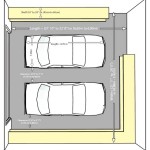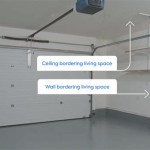Garage Car Mats: A Practical Solution for Snow and Winter Protection
Garage car mats designed for snow and winter conditions represent a practical and effective solution for protecting garage floors from the damaging effects of road salt, snow, slush, and other winter debris. These mats serve as a barrier, preventing corrosive elements from seeping into the concrete or other flooring materials, thereby extending the lifespan of the garage floor and maintaining its aesthetic appeal. The accumulation of snow and ice inside a garage can lead to safety hazards, including slips and falls, and can contribute to moisture-related issues like mold and mildew growth. A quality garage car mat mitigates these risks by providing a contained area for melting snow and facilitating easier cleanup.
The selection of an appropriate garage car mat requires careful consideration of several factors, including the mat's material composition, size, design, and ease of maintenance. While basic mats offer a simple level of protection, more advanced models incorporate features like raised edges to contain larger volumes of water and specialized materials that are resistant to chemicals and abrasion. Understanding the specific needs and conditions of the garage environment is crucial for choosing a mat that will provide optimal performance and longevity.
Key Benefits of Using Garage Car Mats for Snow
One primary benefit of using garage car mats during the winter months is the protection they offer to garage floors. Road salt, often heavily applied to roadways to combat ice, is highly corrosive and can penetrate concrete surfaces, leading to cracking, spalling, and discoloration. Similarly, the constant cycle of freezing and thawing can cause significant damage to the structural integrity of the floor. By containing the snow and slush that enters the garage on vehicles, these mats prevent the direct contact of these damaging elements with the floor, significantly reducing the risk of long-term deterioration. This preventative measure translates to lower maintenance costs and a longer lifespan for the garage floor.
Beyond protecting the floor, garage car mats also enhance safety. The melting snow and ice that accumulate under vehicles can create slippery conditions, increasing the risk of slips and falls. A car mat with a textured surface and raised edges provides a non-slip surface and contains the water, preventing it from spreading across the garage floor. This is particularly important in households with children or elderly individuals, where the risk of injury from falls is higher. By providing a safer environment, garage car mats contribute to the overall well-being of the occupants.
Finally, garage car mats simplify the cleanup process. Instead of having to scrub and mop the entire garage floor to remove salt stains and winter grime, users can simply remove the mat and dispose of the accumulated water and debris. Some mats are designed to be easily cleaned with a hose, while others can be wiped down with a damp cloth. This ease of maintenance saves time and effort, making it easier to keep the garage clean and organized during the challenging winter months. The convenience of a car mat encourages regular cleaning, further preventing the buildup of corrosive substances and maintaining a healthier environment.
The effectiveness of a garage car mat is directly related to its ability to contain and manage the water and debris brought in by vehicles. The design of the mat plays a critical role in this function. Mats with raised edges, often referred to as containment mats, are particularly effective at preventing water from spilling onto the surrounding floor. The height of the edges should be sufficient to accommodate the expected volume of snow and slush, taking into account the size and type of vehicles parked in the garage. Some mats also feature channels or grooves that direct water towards a drain or sump pump, further enhancing their ability to manage large amounts of liquid.
The material composition of the garage car mat is another important factor to consider. Common materials include PVC, rubber, and various types of polymers. PVC mats are generally more affordable but may be less durable and resistant to chemicals than mats made from rubber or specialized polymers. Rubber mats offer excellent traction and are highly resistant to abrasion, making them a good choice for garages that experience heavy use. Polymer mats often offer a combination of durability, chemical resistance, and ease of cleaning. When selecting a material, it is important to consider the specific conditions of the garage environment, including the frequency of use, the type of vehicles parked in the garage, and the potential exposure to chemicals.
The size of the garage car mat should be appropriate for the size of the vehicle and the available space in the garage. A mat that is too small will not provide adequate protection, while a mat that is too large may be cumbersome and difficult to handle. It is generally recommended to choose a mat that is slightly larger than the vehicle's wheelbase to ensure that all of the snow and slush that falls off the vehicle is contained within the mat. When measuring the available space in the garage, it is important to consider any obstructions, such as walls, shelves, or other equipment. It may be necessary to choose a custom-sized mat to fit the specific dimensions of the garage.
Material Considerations
Several materials are commonly used in the construction of garage car mats, each offering distinct advantages and disadvantages. Polyvinyl chloride (PVC) is a widely used option due to its relatively low cost and water resistance. However, PVC mats can become brittle in cold temperatures and may not be as durable as other materials. They are also less resistant to certain chemicals, such as gasoline and oil. While a budget-friendly choice, PVC mats may require more frequent replacement than higher-quality alternatives.
Rubber mats offer superior durability and traction compared to PVC. Rubber is naturally resistant to water and chemicals, and it provides a non-slip surface even when wet. Rubber mats are also more flexible and less prone to cracking in cold temperatures. However, rubber mats can be more expensive than PVC mats, and they may have a strong odor, particularly when new. The odor typically dissipates over time, but it can be a concern for some users. Recycled rubber is a more environmentally friendly option, but it may not be as durable as virgin rubber.
Polypropylene and other synthetic polymers are also used in the construction of garage car mats. These materials offer a good balance of durability, chemical resistance, and ease of cleaning. Polymer mats are often lightweight and easy to handle, and they can be molded into various shapes and sizes. They are also less likely to develop a strong odor compared to rubber mats. However, polymer mats may not be as durable as rubber mats in heavy-use applications. The specific properties of the polymer will vary depending on the manufacturer and the intended use of the mat.
Installation of a garage car mat is typically a straightforward process. Most mats are designed to be simply unrolled and placed on the garage floor. However, some mats may require additional steps, such as trimming to fit a specific space or securing the edges with tape or adhesive. It is important to follow the manufacturer's instructions carefully to ensure proper installation. Before installing the mat, the garage floor should be clean and dry. Any debris or moisture could prevent the mat from adhering properly or create a breeding ground for mold and mildew.
Maintaining a garage car mat is essential for prolonging its lifespan and ensuring its effectiveness. Regular cleaning is necessary to remove accumulated water, salt, and debris. The frequency of cleaning will depend on the amount of snow and slush that is tracked into the garage. In general, it is recommended to clean the mat at least once a week during the winter months. The mat can be cleaned with a hose, a mop, or a brush. A mild detergent can be used to remove stubborn stains. It is important to allow the mat to dry completely before replacing it on the garage floor.
Design and Features
The design and features of a garage car mat can significantly impact its performance and user-friendliness. As mentioned earlier, raised edges are a crucial feature for containing water and preventing it from spilling onto the surrounding floor. The height and design of the edges should be carefully considered based on the expected volume of snow and slush. Some mats feature continuous edges, while others have segmented edges that allow for easier access and drainage. The choice between these designs will depend on the specific needs of the user.
The surface texture of the mat is another important design consideration. A textured surface provides better traction, reducing the risk of slips and falls. The texture can be achieved through various means, such as raised patterns, grooves, or abrasive coatings. The texture should be durable and resistant to wear and tear. Some mats also feature channels or grooves that direct water towards a drain or sump pump, further enhancing their ability to manage large amounts of liquid. These channels can be particularly useful in garages that experience significant amounts of snow and slush.
Some garage car mats are designed with integrated drainage systems. These systems typically consist of a drain hole or sump pump that allows water to be easily removed from the mat. Integrated drainage systems can be particularly useful in garages that do not have a sloped floor or a convenient place to drain the water. The size and location of the drain hole should be carefully considered to ensure that it can effectively remove the accumulated water. The sump pump, if included, should be powerful enough to pump the water out of the garage quickly and efficiently.
In summary, garage car mats offer a valuable solution for protecting garage floors from the damaging effects of snow, salt, and winter debris. By carefully considering the material, size, design, and features of the mat, users can choose a product that meets their specific needs and provides optimal performance. Regular maintenance is essential for prolonging the lifespan of the mat and ensuring its effectiveness. With proper care and attention, a garage car mat can help to keep the garage clean, safe, and well-maintained during the challenging winter months.
Choosing the right garage car mat involves assessing the volume of snow typically brought into the garage. Homes in regions with heavy snowfall will require a mat with higher edges and a larger surface area to contain the melting snow effectively. The number of vehicles parked in the garage matters as well; a single-car garage may only need one mat, while a larger garage with multiple vehicles may require several mats or a custom-sized solution. The frequency of vehicle use is also a factor: vehicles driven daily will deposit more snow and debris than those used infrequently. Taking these factors into account will help in determining the ideal size and containment capacity of the garage car mat.
The long-term cost-effectiveness of a garage car mat should be factored into the purchasing decision. While inexpensive mats may seem appealing initially, they often lack durability and may need frequent replacement. Investing in a higher-quality mat made from durable materials can save money in the long run by reducing the need for replacements and minimizing damage to the garage floor. Consider the warranty offered by the manufacturer as an indication of the mat's expected lifespan and performance. A longer warranty suggests that the manufacturer has confidence in the product's durability and resistance to wear and tear.
Finally, environmental considerations are becoming increasingly important for many consumers. Choosing a garage car mat made from recycled materials is a more sustainable option that reduces the environmental impact of the product. Some manufacturers also offer take-back programs, allowing customers to return used mats for recycling. By considering the environmental footprint of the mat, consumers can make a more responsible purchasing decision that aligns with their values.

Autofloorguard Afg8520 8 5 Ft By 20 Suv Truck Size Garage Containment Mat

Garage Car Mat Black Containment Floor For Snow Mud Rain 8ft 6in X 20ft And 22oz Vinyl Wash Mats Price Made In Com

Yescom Containment Mat Garage Floor For Suv Snow Mud Compact Size 7 9 X16 Ebay

Trucontain Containment Mat 2 All Garage Floors

Yescom 7 9 X16 Containment Mat Garage Floor For Suv Snow Mud Rain Compact Size

Dirt Floor Snow Absorbing Car Garage Mat Washable Felt And Waterproof Backing Price Made In Com

Goplus Garage Floor Mat 22 X 9 For Under Car Waterproof Protection From Snow Rain Mud 18 7

Garage Floor Mat 7 4 X17 Waterproof Protection From Water Snow Rain Mud And Oil For Cars Non Slip Heavy Duty Containment With Tpe Anti Leak

Snowblower Containment Mat For Garage Autofloorguard

Trucontain Containment Mat 2 All Garage Floors








